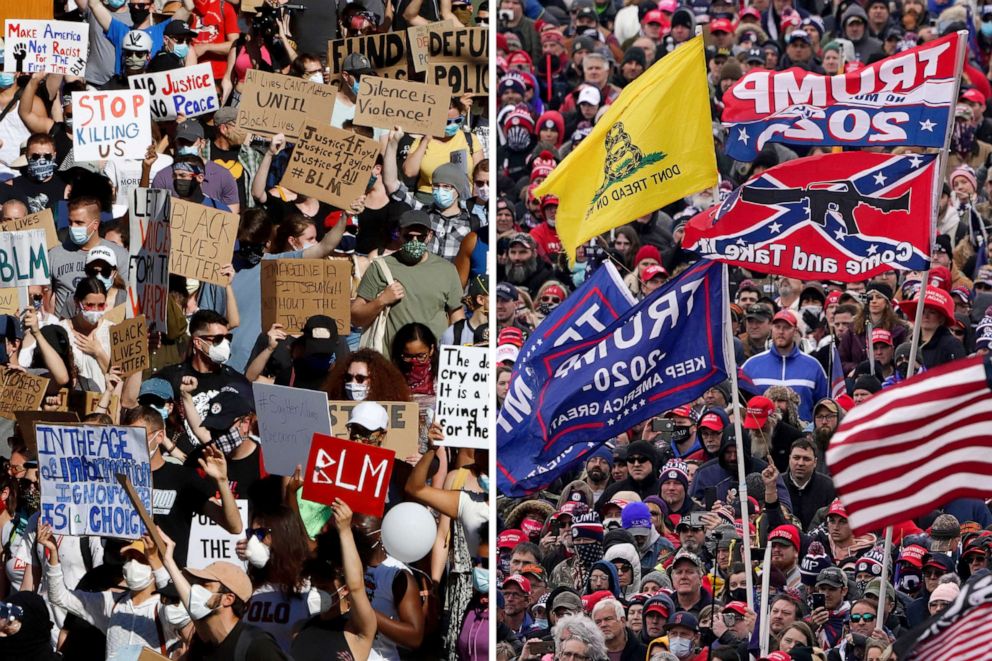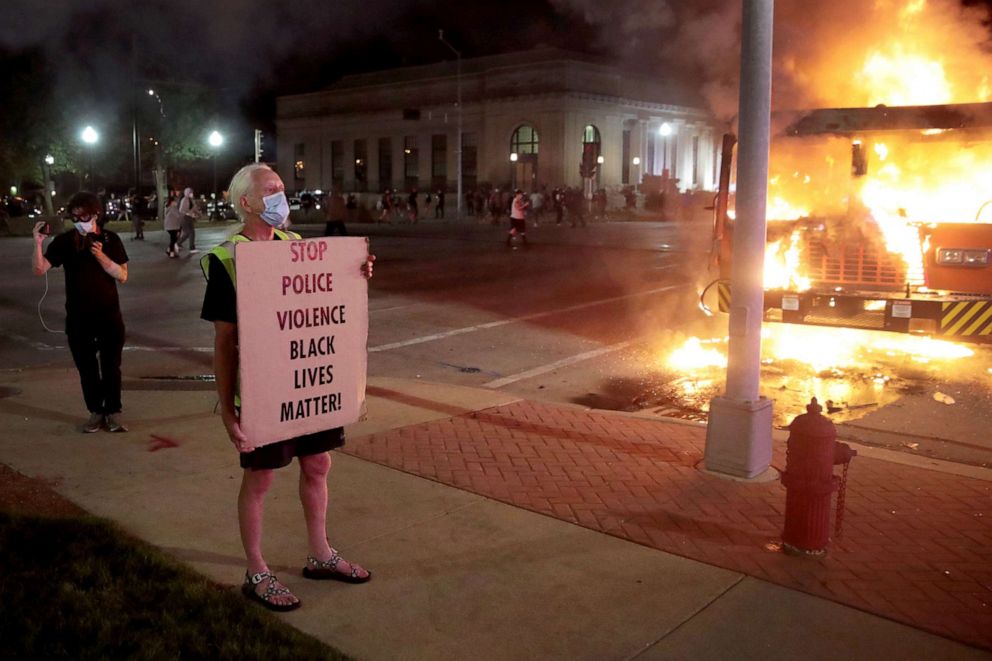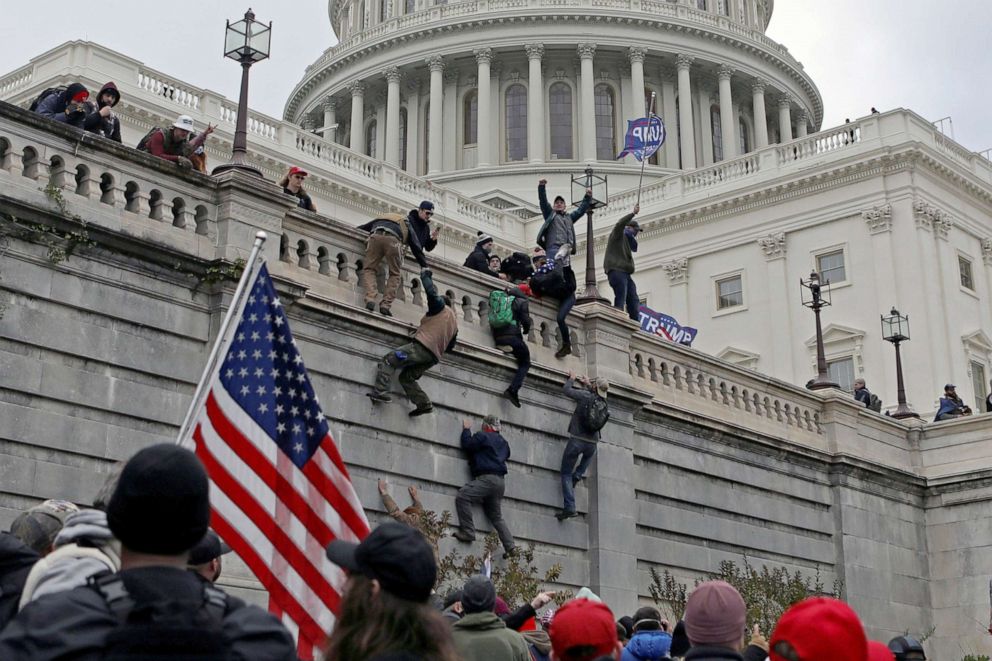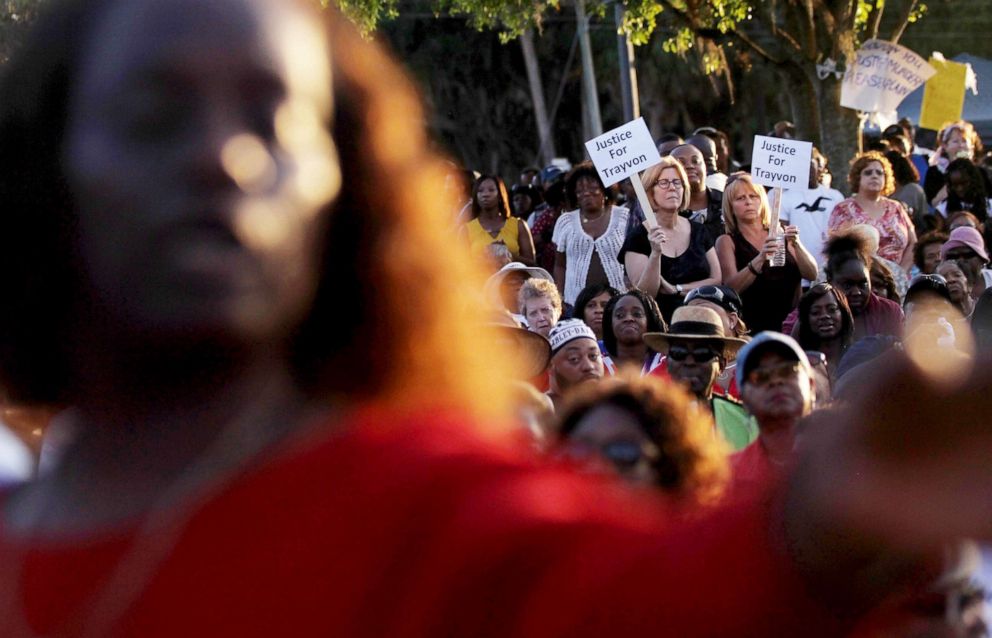False equivalency between Black Lives Matter and Capitol siege: Experts, advocates
Comparisons are "absurd," they said.
Fiery exchanges took place when House lawmakers convened Wednesday to impeach President Donald Trump for a historic second time, just one week after a mob of his supporters attacked the Capitol grounds. As Democrats railed against the insurrectionists, some Republicans repeatedly drew comparisons between last summer's Black Lives Matter protests and the Capitol siege of Jan. 6.

Comparisons between Black Lives Matter and what happened on Capitol Hill are false equivalencies, said several experts and advocates who spoke with ABC News.
'They lit actual flames!'
During Wednesday's hearing, several Congress members made impassioned cases for and against impeaching President Trump. During these speeches, some lawmakers denounced what they called the white supremacy among the Capitol rioters, while others accused Democrats of hypocrisy by supporting Black Lives Matter protests but condemning Trump supporters.
"If we fail to remove a White supremacist president who incited a white supremacist insurrection, it's communities like Missouri's first district that suffer the most," said Rep. Cori Bush of Missouri during her speech in support of impeachment. "The 117th Congress must understand that we have a mandate to legislate in defense of Black lives, the first step in that process is to root out white supremacy starting with impeaching the White supremacist in chief."
Rep. Bush made history as the first Black Congresswoman to be elected in the state. Missouri’s first district has a majority Black population and usually leans blue, according to an election website.

In her speech during the hearing, Rep. Maxine Waters, D-Calif., condemned the president for "radicalizing his supporters" and "inciting them to willingly join with White supremacists, Neo-Nazis and para-military extremists in a siege of the United States Capitol building."
In a video statement released following the vote, the president condemned last week's violence, but did not take responsibility for his role in the events. In the past, the president has denied accusations of racism. During the final presidential debate on Oct. 22, when moderator Kristen Welker asked the president about racial strife and hate in America, he answered by saying he is the "least racist person in this room."
Instead of rebuking the president for any role in inciting the riot, some Republicans drew comparisons between the Capitol siege and the Black Lives Matter protests that swept across the nation last year following the deaths of George Floyd, Breonna Taylor and several victims of police brutality.
Republican Rep. Matt Gaetz of Florida defended Trump, saying "some have cited the metaphor that the president lit the flames... Well, they lit actual flames!" accusing Democrats of enabling civil unrest that ensued in some cities during the BLM protests.
The unrest in some cities after some Black Lives Matter protests included vandalism and looting; however, many of these events were rooted in confrontations with police after peaceful protesters left. The vast majority of demonstrations were peaceful and leading BLM activists repeatedly distanced themselves from agent provocateurs and instigators.
BLM and the failed Capitol insurrection cannot be compared, according to Cynthia Miller-Idriss, professor of education and sociology at American University and author of "Hate in the Homeland: The New Global Far Right."
"I don't see a parallel between the two," said Miller-Idriss. "I think making a connection that there was actually incitement of violence or that there's any equivalence in the violence itself, is just absurd."
“What happened at the Capitol, you can't call that a protest anymore,” said Miller-Idriss. “That was a riot, it was sedition, it was an insurrection, a siege...it was a domestic terrorist attack.”
Stark differences have been pointed out between the protests for racial justice and the riot stoked by unfounded claims of a stolen presidential election.
2 sets of rules?
The majority white "Stop the Steal" mob that stormed the nation's Capitol building was a mix of several right-wing extremist groups, according to Larry Rosenthal, chair and lead researcher of the Berkeley Center for Right-Wing Studies.
Some were members of far-right armed militias. Others were right-wing populists, whom he described as "rally-goers" who are "fanatical about Donald Trump and his presidency."

Rosenthal also described two subsets within the extremist groups. One, is comprised of anti-government militias, whom he referred to as "people who don't recognize the legitimacy" of government on both state and local levels and often deem themselves "sovereign citizens." The other includes white nationalists, those he said are "electrified and mobilize[d] going on the streets to stand up to Black Lives Matter and the fantasy of Antifa".
"Donald Trump asserts his role as the leader of the right-wing militias," said Rosenthal. "Those people who call themselves 'patriots,' they have lived with the idea of a spark that would lead to the civil war ... it's been in their largely fantasy world for four decades. And suddenly, there is this summons from the president of the United States."
There was a "stark difference" in the makeup of the Black Lives Matter protests and the Capitol riots, according to professor Mark Anthony Neal, chair of the Department of African and African American Studies at Duke University.
Neal described the Black Lives Matter protests last year as "a multi-racial social justice movement, much like the civil rights movement in the 1960s."
"Many people of color, Black folks, are killed doing mundane things … just literally sleeping in their home, walking down the block," Neal told ABC News. "What Black Lives Matter was trying to bring to the forefront was the ways in which Black and people of color are always over-policed."
Non-violent protesters during the summer faced brute force from federal officers, but rioters were met with minimal federal response.
"[Rioters] acted with an extraordinary sense of impunity," said Rosenthal. "Like nothing was going to happen to them."
Federal authorities launched an active investigation into the attack on the Capitol and there are over 275 open investigations, Acting U.S. Attorney Michael Sherwin told reporters on a conference call Friday. As of 8 a.m. Friday morning, the Department of Justice opened 98 criminal cases -- a majority of which are federal felony cases, Sherwin said.

Marc Morial, president and CEO of the National Urban League, said the double standard in policing is "a long-standing issue of both covert and overt racism and how law enforcement reacts to protest. When Black people are protesting ... there's an over-militarization of communities. "
"It was as though two sets of rules apply," Morial said. "One set for these [pro-Trump] protesters and another set for not just Black Lives Matter but also civil rights protests."
Motivation behind the movements
Rioters that led the insurrection on the Capitol were a mix of "far-right extremists" and self-proclaimed patriots who believe they were called to defend democracy, according to Miller-Idriss. She described how some were "intentional in their planning" and arrived "tactically prepared to storm the Capitol" carrying weapons, cuffs and mace.
These far-right extremist groups were united by "a commitment to a tremendous set of disinformation about the election" citing unfounded claims of massive voter fraud and an illegitimate election, Miller-Idriss said.
President-elect Joe Biden won the election by more than 70 electoral votes. His victory was certified when Congress convened to ratify the Electoral College vote on Jan. 6. However, weeks after the election, Trump continuously pushed false claims and baseless theories of a rigged election, leading some to argue that it incited his followers and contributed to the siege of the Capitol.

The rioters also displayed symbols of white supremacist extremism including a noose stationed across the Capitol which, according to Miller-Idriss, "symbolizes the horrific history of lynching," but also refers to a white supremacy code that signals a "day of reckoning when traitors will be hung in the streets."
These groups were motivated by a sense of threat, Miller-Idriss said -- a "precarity" or "fear of something being taken away" they believed they deserve is what signaled the attacks on the Capitol, which she said is different from disenfranchisement felt by those supporting Black Lives Matter.
The Black Lives Matter movement was founded in 2013 after the verdict in the murder trial for the killing of Trayvon Martin, a Black teenager who was killed while walking home in Florida.
Amid a racial reckoning in 2020, BLM protests across the country fought against racial injustice, police brutality and advocated for numerous Black Americans that had been violently killed.
Neil said it's important to make the distinction between the Black Lives Matter movement and the Capitol siege.
"One movement, in the case of Black Lives Matter, is really a critique, an attempt to undermine white supremacy. In the latter case, what happened at the Capitol in January was an attempt to buttress white supremacy."
ABC News' Alexander Mallin contributed to this report.




